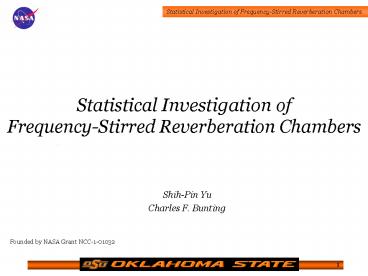Statistical Investigation of FrequencyStirred Reverberation Chambers - PowerPoint PPT Presentation
1 / 22
Title:
Statistical Investigation of FrequencyStirred Reverberation Chambers
Description:
Charles F. Bunting. Founded by NASA Grant NCC-1-01032. Oklahoma State University ... Reverberation chamber is an electrically large cavity consisting of metal walls ... – PowerPoint PPT presentation
Number of Views:172
Avg rating:3.0/5.0
Title: Statistical Investigation of FrequencyStirred Reverberation Chambers
1
Statistical Investigation of Frequency-Stirred
Reverberation Chambers
- Shih-Pin Yu
- Charles F. Bunting
Founded by NASA Grant NCC-1-01032
2
What is the Reverberation Chamber ?
Statistical Investigation of Frequency-Stirred
Reverberation Chambers
- Reverberation chamber is an electrically large
cavity consisting of metal walls with a
perturbation mechanism inside to obtain an
uniform, isotropic and randomly polarized
electromagnetic environment throughout the
working volume. - Conventional way to perturb the field inside the
chamber is by using metallic stirrer/tuner(s) to
continuously change the boundary conditions in
the chamber. - A novel way to perturb the field is by using a
amplitude and frequency modulated source instead
of a CW source.
3
Mechanical-Stirred Reverberation Chambers
RTCA/DO-160D, "Environmental Conditions and Test
Procedures for Airborne Equipment (Draft 9 for
the Change Notice to Section 20)," October
6,2000.
4
Frequency-Stirred Reverberation Chambers
- The rotation of the mechanical stirrer has
equivalent effect to frequency and amplitude
modulation.
Frequency domain
Time domain
D. I. Wu and D. C. Chang, "The Effect of an
Electrically Large Stirrer in a Mode-Stirred
Chamber,1989
5
Frequency-Stirred Reverberation Chambers
M. L. Crawford, T. A. Loughry, M. O. Hatfield,
and G. J. Freyer, "Band-limited, White Gaussian
Noise Excitation for Reverberation Chambers and
Applications to Radiated Susceptibility
Testing," National Institute of Standards and
Technology Technical Note 1375, 1996.
6
Why Frequency-Stirred Reverberation Chambers ?
- Real-time homogeneous field can be achieved.
- Test time reduced up to a factor of 200 compare
with mechanical stirring.
7
How to achieve it ?
- There are many ways to achieve frequency stirring
by using different sources, one of them is Band
Limited White Gaussian Noise (BLWGN) source. - By given a designated source bandwidth, the
frequency stirring can be applied to
reverberation chambers.
8
Hills 2-D simulation (1994)
- D. A. Hill performed a 2-D simulation in 1994
using a electric line source for frequency
stirring and obtain a good field uniformity
result.
Line source
9
Is Field Uniformity Good Enough ?
10
Statistics of the E-field (2-D)
11
The Effects on the Statistics
- Mode structure
12
The Effects on the Statistics
- Mode structure
High number of possible modes !
13
The Effects on the Statistics
- Line source bandwidth
Several modes exist even in 1 MHz BW !
14
The Effects on the Statistics
- Chamber Q
15
How to Improve the Result ?
- Lower chamber Q
- Increase the line source bandwidth
Standard derivation lower than 1 dB!
16
Statistics with lower Chamber Q
Worse Standard derivation due to lower Q !
17
Statistics with increased line source band width
Better curve fitting !
18
3-D Simulation using Modal_MoM
- Modal_MoM was developed by M.D. Deshpande for the
simulation of the shielding effectiveness of the
lossless cavity with apertures on it. - A 3-D simulation of frequency stirring is
performed by using the aperture as the excitation
source to the chamber.
19
3-D Simulation using Modal_MoM
20
Statistics of the E-field (3-D)
21
Conclusion and Future Work
- In 2-D simulation the field uniformity dose not
indicate good statistics of the field itself. - In 2-D simulation, in order to be analogous to
mechanical stirring, the chamber Q and the line
source bandwidth should be carefully choose.
22
Conclusion and Future Work
- The 3-D simulation of a lossless cavity shows
poor field uniformity and field statistics
indicate not enough modes existing in the
frequency stirring simulation. - A thorough investigation should be performed for
further use of the real frequency stirring in
reverberation chambers.































